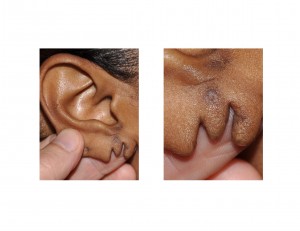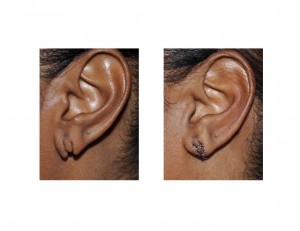The earlobe is most commonly recognized for its ability to retain a variety of different ornaments. Whether it be a piercing or a clip-on ear ring, the relatively small earlobe usually holds up well to support the weight of jewelry. But the earlobe is a rather delicate structure and is the weakest component of one’s ear. Because it lacks any cartilage like the rest of the ear, heavy ear rings or inadvertent pulling on a dangling ear ring can cause a tear or split ear lobe deformity.
The vast majority of split or near-split earlobes are vertical in orientation and singular in number. This is because most people only place one ear ring in the lobe. While some have multiple piercings, they usually are placed higher up along the helical rim away from the ear lobe proper. This is likely because of a spacing issue for the piercings but is also wise biologically due to the thin tissue of the earlobe and blood supply concerns.

This M-split earlobe poses some small challenges in reconstruction. Do you keep the central island of skin between the splits, creating a final Y-shape scar in the earlobe when it is put back together? Or do you remove the central skin segment creating the more typical single vertical line scar albeit it longer due to the need to remove the bunching above it.?While these are seemingly minor issues, one may not think so if it were their earlobe.
By keeping the central skin island and the Y-shaped scar, the size and shape of the earlobe will be kept normal. Discarding the middle tissue island of the M-split and closing as a single vertical line can make the earlobe smaller. As usual, either choice has its tradeoffs.

The double-split earlobe deformity is caused by the unwise decision to place two piercings in the unsupported soft tissue of the earlobe. Double earlobe piercings increase the risk of vertical tissue splits. Its earlobe reconstruction is best initially approached by central island preservation which keeps a more normal earlobe appearance.
Dr. Barry Eppley
Indianapolis, Indiana


